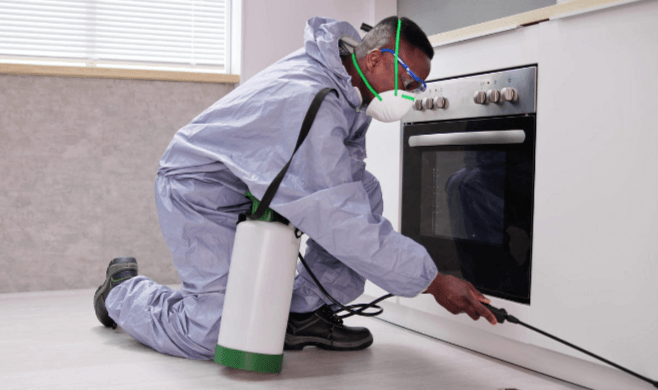The Importance of Regular Pest Inspections

Introduction
Pest infestations can be more than just a nuisance; they can pose significant health risks, cause extensive property damage, and lead to financial strain. Whether in residential homes, commercial establishments, or industrial facilities, pests can infiltrate spaces, often undetected until the damage is done. This is why regular pest inspections are vital. They serve as a proactive measure to identify potential issues before they escalate, ensuring a safe, clean, and healthy environment. In this article, we’ll delve into the importance of regular pest inspections, exploring how they can protect your property, health, and financial well-being.
Understanding Pest Inspections
A pest inspection is a thorough examination of a property by a trained professional to detect the presence of pests or conditions conducive to infestations. This process typically involves a detailed inspection of both the interior and exterior of a building, including the foundation, walls, roof, and surrounding areas. The goal is to identify any signs of current infestations, potential entry points, and factors that might attract pests, such as moisture, food sources, or clutter.
During a pest inspection, professionals look for evidence of various pests, including termites, rodents, cockroaches, ants, spiders, and more. They may also check for structural issues, such as cracks or holes, that could allow pests to enter. By conducting these inspections regularly, property owners can stay ahead of potential problems, addressing issues before they become severe.
Health Risks Associated with Pest Infestations
Pests are not just an annoyance; they can carry a multitude of health risks. For example, rodents are known to spread diseases such as hantavirus and leptospirosis, while cockroaches can trigger asthma and allergic reactions, especially in children. Mosquitoes, another common pest, are vectors for serious diseases like West Nile virus, Zika virus, and malaria.
Regular pest inspections can help mitigate these risks by identifying and eliminating pest populations before they have a chance to spread diseases. By maintaining a pest-free environment, you reduce the likelihood of illnesses spreading to family members, employees, or customers. This is particularly important in environments such as schools, hospitals, and restaurants, where the health of vulnerable populations is at stake.
Preventing Property Damage through Inspections
Pest infestations can cause significant damage to buildings and their contents. Termites, for example, are notorious for their ability to destroy wooden structures, often going unnoticed until the damage is extensive. Rodents can chew through electrical wiring, leading to fire hazards, and can also damage insulation, pipes, and even furniture.
Regular pest inspections help in early detection of such issues, allowing property owners to take corrective actions before the damage becomes extensive and costly. Early intervention can save thousands of dollars in repair costs, making regular inspections a smart investment for property owners.
The Financial Benefits of Regular Pest Inspections
While the upfront cost of a pest inspection might seem like an added expense, it’s a cost-effective strategy in the long run. Identifying and addressing pest issues early can prevent the need for expensive repairs, replacement of damaged goods, or even medical bills due to pest-related health issues.
Moreover, regular pest inspections can maintain or even increase the value of a property. In real estate, a history of regular pest inspections can be a selling point, assuring potential buyers that the property has been well-maintained and is free from infestations. This proactive approach can lead to quicker sales and higher property values.
Protecting Your Business Reputation
For businesses, especially those in the hospitality and food service industries, a single pest sighting can be disastrous. Customers expect a clean and safe environment, and the presence of pests can quickly lead to negative reviews, loss of customers, and potential legal action. Regular pest inspections are essential for businesses to protect their reputation and ensure compliance with health and safety regulations.
By conducting regular inspections, businesses can address potential issues before they impact operations or customer satisfaction. This proactive approach not only helps in maintaining a positive reputation but also ensures that the business remains in good standing with local health authorities.
Common Pests Identified During Inspections
Different types of pests can infest a property, each bringing its own set of challenges. Some of the most common pests identified during regular inspections include:
- Termites: Often called “silent destroyers,” termites can cause extensive damage to wooden structures.
- Rodents: Mice and rats can cause structural damage, contaminate food, and spread diseases.
- Cockroaches: These pests are resilient and can quickly multiply, leading to infestations that are difficult to control.
- Ants: While some ants are merely a nuisance, others, like carpenter ants, can damage wood and other building materials.
- Spiders: Although most spiders are harmless, their presence can be unsettling, and some species can be dangerous.
- Bed Bugs: These pests are difficult to eliminate once they infest a space and can cause significant discomfort and distress.
Regular inspections help in the early detection of these and other pests, allowing for targeted treatment and prevention strategies.
The Role of Professional Pest Inspectors
Professional pest inspectors bring expertise and experience to the table, which is crucial for identifying and addressing pest issues effectively. They are trained to recognize the subtle signs of infestations that might go unnoticed by the untrained eye. Moreover, they use specialized tools and techniques to inspect hard-to-reach areas, ensuring a thorough examination.
In addition to identifying pests, professional inspectors can provide valuable advice on how to prevent future infestations. This might include recommendations for sealing entry points, reducing moisture levels, or changing landscaping practices that attract pests. By working with a professional, property owners can develop a comprehensive pest management plan that addresses both current issues and potential risks.
The Impact of Seasonal Changes on Pest Activity
Pest activity often varies with the seasons, which is why regular inspections are important year-round. For example, rodents and insects might seek shelter indoors during the colder months, while spring and summer might see an increase in ant and termite activity.
By scheduling pest inspections at regular intervals throughout the year, property owners can stay ahead of seasonal pest trends. This proactive approach ensures that any increase in pest activity is quickly detected and addressed, minimizing the risk of infestations taking hold.
Integrating Pest Inspections into Property Maintenance Plans
For property managers and homeowners alike, integrating regular pest inspections into the broader maintenance plan is essential. Just as routine inspections of HVAC systems, roofing, and plumbing are standard practice, pest inspections should be included as a critical component of property upkeep.
A well-rounded maintenance plan that includes pest inspections helps in maintaining the overall health and longevity of the property. It also ensures that any potential issues are addressed promptly, preventing small problems from becoming major headaches.
DIY vs. Professional Pest Inspections
While some property owners may consider conducting their own pest inspections, there are significant advantages to hiring a professional. DIY inspections often lack the thoroughness and expertise required to detect early signs of infestation. Moreover, professionals are trained to handle potentially hazardous situations, such as dealing with venomous spiders or large rodent populations.
However, for those who prefer a hands-on approach, there are steps that can be taken between professional inspections. Regularly checking for signs of pests, such as droppings, nests, or chewed materials, can help in early detection. Keeping the property clean and free of clutter also reduces the chances of attracting pests.
Legal Implications of Pest Infestations
In some regions, property owners are legally required to maintain pest-free premises, especially in rental properties. Failure to do so can result in fines, lawsuits, or other legal consequences. Regular pest inspections help property owners stay compliant with local regulations, reducing the risk of legal action.
For landlords, ensuring that rental properties are free from pests is not just a legal obligation but also a moral one. Tenants have the right to live in a safe and healthy environment, and regular inspections are a crucial part of fulfilling this responsibility.
The Connection Between Pest Inspections and Environmental Sustainability
Regular pest inspections can also contribute to environmental sustainability. By identifying and addressing pest issues early, the need for extensive chemical treatments is reduced, which in turn minimizes the impact on the environment. Furthermore, many pest control companies now offer eco-friendly options that are safer for both humans and wildlife.
By choosing sustainable pest management practices, property owners can protect the environment while still maintaining a pest-free space. This approach not only benefits the planet but also appeals to environmentally conscious consumers and tenants.
Educational Value of Regular Pest Inspections
Regular pest inspections also serve an educational purpose, helping property owners and residents understand the importance of proactive pest management. Inspectors can provide valuable insights into the habits and behaviors of pests, as well as tips on how to make the property less attractive to them.
This knowledge empowers property owners to take preventive measures, such as proper food storage, regular cleaning, and maintenance of the property’s exterior. By understanding the factors that contribute to pest infestations, property owners can make informed decisions that protect their investments.
How Often Should Pest Inspections Be Conducted?
The frequency of pest inspections depends on several factors, including the type of property, its location, and its history of pest problems. Generally, it is recommended to have a pest inspection at least once a year. However, properties in areas with high pest activity or those that have had previous infestations may require more frequent inspections.
For businesses, particularly those in the food service industry, quarterly inspections are often necessary to ensure compliance with health regulations. Residential properties, on the other hand, may only need annual inspections unless specific issues arise.
Choosing the Right Pest Inspection Service
When selecting a pest inspection service, it’s important to choose a reputable company with experienced professionals. Look for companies that are licensed and insured, with a proven track record of successful pest management. Reading reviews and asking for recommendations can also help in making an informed decision.
In addition to their qualifications, consider the range of services offered by the inspection company. Some companies provide integrated pest management (IPM) services, which focus on long-term prevention through a combination of techniques. This holistic approach can be more effective and sustainable in the long run.
Pest Inspections as Part of a Pre-Purchase Property Evaluation
For those buying a new property, a pest inspection is a crucial step in the pre-purchase evaluation process. Discovering a pest problem after purchasing a property can lead to unexpected expenses and stress. A thorough pest inspection can reveal hidden issues, allowing potential buyers to make informed decisions or negotiate repairs before finalizing the purchase.
Including a pest inspection in the pre-purchase checklist provides peace of mind and ensures that the investment is protected from the outset. It’s a small cost compared to the potential financial implications of buying a property with an undiscovered infestation.
Addressing Pest Issues Post-Inspection
Once a pest inspection is completed, it’s essential to act on the findings promptly. Whether it’s sealing entry points, repairing structural damage, or scheduling a treatment, addressing issues immediately can prevent them from escalating. Ignoring the recommendations from a pest inspection can lead to more significant problems down the line, including severe infestations and costly repairs.
A proactive approach to pest management, guided by regular inspections, ensures that any issues are dealt with efficiently and effectively. This not only protects the property but also contributes to a healthier living or working environment.
FAQs
What are the signs that I need a pest inspection?
Common signs include unexplained damage to property, droppings, nests, strange noises (like scratching), or even sightings of pests themselves. If you notice any of these, it’s time to schedule an inspection.
How do pest inspections differ from pest control?
Pest inspections are about detecting potential problems, while pest control involves treating existing infestations. Inspections are a preventative measure, whereas pest control is reactive.
Can I conduct my own pest inspection?
While you can check for obvious signs of pests, a professional inspection is recommended for thoroughness and accuracy. Professionals have the expertise to spot issues that may not be visible to the untrained eye.
How often should I schedule pest inspections?
For most properties, annual inspections are sufficient. However, high-risk areas or properties with a history of infestations may require more frequent inspections.
What should I do if pests are found during an inspection?
Follow the recommendations of your pest inspector, which may include treatment, repairs, or preventative measures. Acting quickly can prevent further damage and more severe infestations.
Are pest inspections necessary for new buildings?
Yes, even new buildings can have pest issues, particularly if they are located in areas with high pest activity. Regular inspections help ensure that the property remains pest-free from the start.
Conclusion
Regular pest inspections are a critical aspect of maintaining a safe, healthy, and pest-free environment. They offer numerous benefits, including early detection of potential issues, prevention of property damage, protection of health, and financial savings. By integrating pest inspections into your regular property maintenance routine, you can safeguard your investment, avoid costly repairs, and enjoy peace of mind. Whether you’re a homeowner, business owner, or property manager, prioritizing regular pest inspections is a wise and essential decision.




